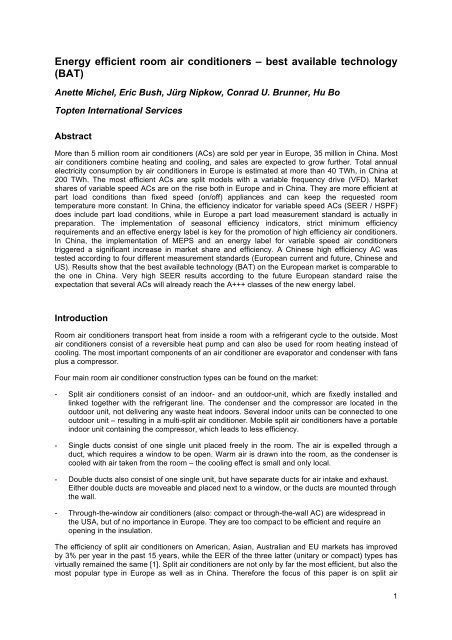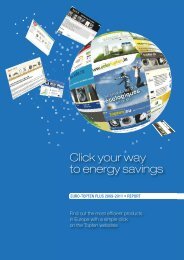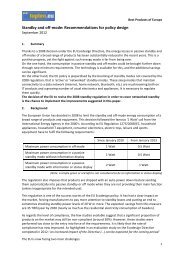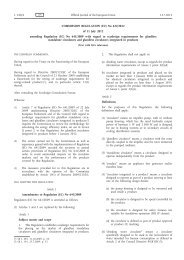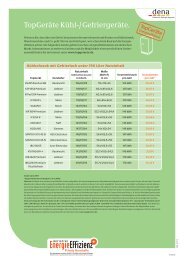Energy efficient room air conditioners - best available ... - topten.eu
Energy efficient room air conditioners - best available ... - topten.eu
Energy efficient room air conditioners - best available ... - topten.eu
Create successful ePaper yourself
Turn your PDF publications into a flip-book with our unique Google optimized e-Paper software.
<strong>Energy</strong> <strong>efficient</strong> <strong>room</strong> <strong>air</strong> <strong>conditioners</strong> – <strong>best</strong> <strong>available</strong> technology<br />
(BAT)<br />
Anette Michel, Eric Bush, Jürg Nipkow, Conrad U. Brunner, Hu Bo<br />
Topten International Services<br />
Abstract<br />
More than 5 million <strong>room</strong> <strong>air</strong> <strong>conditioners</strong> (ACs) are sold per year in Europe, 35 million in China. Most<br />
<strong>air</strong> <strong>conditioners</strong> combine heating and cooling, and sales are expected to grow further. Total annual<br />
electricity consumption by <strong>air</strong> <strong>conditioners</strong> in Europe is estimated at more than 40 TWh, in China at<br />
200 TWh. The most <strong>efficient</strong> ACs are split models with a variable frequency drive (VFD). Market<br />
shares of variable speed ACs are on the rise both in Europe and in China. They are more <strong>efficient</strong> at<br />
part load conditions than fixed speed (on/off) appliances and can keep the requested <strong>room</strong><br />
temperature more constant. In China, the efficiency indicator for variable speed ACs (SEER / HSPF)<br />
does include part load conditions, while in Europe a part load measurement standard is actually in<br />
preparation. The implementation of seasonal efficiency indicators, strict minimum efficiency<br />
requirements and an effective energy label is key for the promotion of high efficiency <strong>air</strong> <strong>conditioners</strong>.<br />
In China, the implementation of MEPS and an energy label for variable speed <strong>air</strong> <strong>conditioners</strong><br />
triggered a significant increase in market share and efficiency. A Chinese high efficiency AC was<br />
tested according to four different measurement standards (European current and future, Chinese and<br />
US). Results show that the <strong>best</strong> <strong>available</strong> technology (BAT) on the European market is comparable to<br />
the one in China. Very high SEER results according to the future European standard raise the<br />
expectation that several ACs will already reach the A+++ classes of the new energy label.<br />
Introduction<br />
Room <strong>air</strong> <strong>conditioners</strong> transport heat from inside a <strong>room</strong> with a refrigerant cycle to the outside. Most<br />
<strong>air</strong> <strong>conditioners</strong> consist of a reversible heat pump and can also be used for <strong>room</strong> heating instead of<br />
cooling. The most important components of an <strong>air</strong> conditioner are evaporator and condenser with fans<br />
plus a compressor.<br />
Four main <strong>room</strong> <strong>air</strong> conditioner construction types can be found on the market:<br />
- Split <strong>air</strong> <strong>conditioners</strong> consist of an indoor- and an outdoor-unit, which are fixedly installed and<br />
linked together with the refrigerant line. The condenser and the compressor are located in the<br />
outdoor unit, not delivering any waste heat indoors. Several indoor units can be connected to one<br />
outdoor unit – resulting in a multi-split <strong>air</strong> conditioner. Mobile split <strong>air</strong> <strong>conditioners</strong> have a portable<br />
indoor unit containing the compressor, which leads to less efficiency.<br />
- Single ducts consist of one single unit placed freely in the <strong>room</strong>. The <strong>air</strong> is expelled through a<br />
duct, which requires a window to be open. Warm <strong>air</strong> is drawn into the <strong>room</strong>, as the condenser is<br />
cooled with <strong>air</strong> taken from the <strong>room</strong> – the cooling effect is small and only local.<br />
- Double ducts also consist of one single unit, but have separate ducts for <strong>air</strong> intake and exhaust.<br />
Either double ducts are moveable and placed next to a window, or the ducts are mounted through<br />
the wall.<br />
- Through-the-window <strong>air</strong> <strong>conditioners</strong> (also: compact or through-the-wall AC) are widespread in<br />
the USA, but of no importance in Europe. They are too compact to be <strong>efficient</strong> and require an<br />
opening in the insulation.<br />
The efficiency of split <strong>air</strong> <strong>conditioners</strong> on American, Asian, Australian and EU markets has improved<br />
by 3% per year in the past 15 years, while the EER of the three latter (unitary or compact) types has<br />
virtually remained the same [1]. Split <strong>air</strong> <strong>conditioners</strong> are not only by far the most <strong>efficient</strong>, but also the<br />
most popular type in Europe as well as in China. Therefore the focus of this paper is on split <strong>air</strong><br />
1
<strong>conditioners</strong>. The most energy <strong>efficient</strong> split <strong>air</strong> <strong>conditioners</strong> have a variable frequency drive (VFD)<br />
and a permanent-magnet motor. The VFD allows the <strong>air</strong> conditioner’s compressor to run at part load<br />
and adapt its workload to the temperature change needed. Fixed speed <strong>air</strong> <strong>conditioners</strong> on the other<br />
hand reach a certain temperature by switching from full load operation to off, which is not very<br />
<strong>efficient</strong>.<br />
The current EU energy label for <strong>air</strong> <strong>conditioners</strong> refers to the <strong>Energy</strong> Efficiency Ratio (EER, cooling<br />
function) and Co<strong>efficient</strong> Of Performance (COP, heating function) to indicate the energy efficiency of<br />
<strong>air</strong> <strong>conditioners</strong>. These indicators are measured at full load operation and do not account for the<br />
efficiency gains by the variable speed drives’ ability to work at part load. Seasonal efficiency<br />
indicators (SEER for cooling, SCOP or Heating Seasonal Performance Factor (HSPF) for heating) do<br />
consider the different cooling or heating needs during the year and include part load operation of <strong>air</strong><br />
<strong>conditioners</strong>. Many non-EU countries have been applying seasonal efficiency indicators, while the EU<br />
is about to introduce them now.<br />
Air conditioner markets in Europe and China: trends, <strong>best</strong> <strong>available</strong><br />
technology (BAT) and energy consumption<br />
Europe<br />
Market trends<br />
Annual <strong>air</strong> conditioner sales in the EU are expected to grow from 4.9 million units in 2005 to almost 10<br />
million by 2020. At the same time the stock will increase from around 40 million units to 110 million<br />
installed <strong>air</strong> <strong>conditioners</strong> [2].<br />
National markets across the EU differ strongly due to different climate, building design, legislation and<br />
income. In Southern countries for instance heating with <strong>air</strong> <strong>conditioners</strong> is common, while houses in<br />
Northern countries usually have central heating installed. Across Europe, about 75% of the sold <strong>air</strong><br />
<strong>conditioners</strong> include a reversible heat pump capable of cooling and heating. Variable speed (inverter)<br />
<strong>air</strong> <strong>conditioners</strong> have also become popular: in 2007 55%-75% of the sales were <strong>air</strong> <strong>conditioners</strong> with a<br />
variable speed drive. Sales shares of both reversible heat pumps and variable speed <strong>air</strong> <strong>conditioners</strong><br />
are expected to grow further, while split cooling only appliances (without heating function) are<br />
expected to disappear from the market. Single ducts and double ducts, today accounting for about<br />
15% of the sales, are expected to become more popular however [2].<br />
Sales data from 5 European countries from 2005 - 2008 (till October) show that class A <strong>air</strong><br />
<strong>conditioners</strong> by now account for most of the sales (Fig. 1).<br />
!<br />
Figure 1: Air conditioner sales in 5 EU-countries (France, Germany, Italy, Poland, Great Britain)<br />
2004 – October 2008. Source: GfK data in [3].!<br />
2
This market evolution seems to have been triggered mainly by the introduction of the energy label for<br />
<strong>air</strong> <strong>conditioners</strong> in 2002 [4]. By now high efficiency <strong>air</strong> <strong>conditioners</strong> reach <strong>Energy</strong> Efficiency Ratio<br />
(EER) values of up to 5.63 [5] - way beyond the class A threshold of 3.2.<br />
<strong>Energy</strong> efficiency: Best <strong>available</strong> technology (BAT) and average <strong>air</strong> <strong>conditioners</strong><br />
Split <strong>air</strong> <strong>conditioners</strong> with a variable speed drive and a permanent-magnet motor are the most energy<br />
<strong>efficient</strong> <strong>air</strong> <strong>conditioners</strong>. For the heating mode, some products switch to electrical resistance heating,<br />
a highly in<strong>efficient</strong> way of heating. Potentially <strong>efficient</strong> are products with a reversible heat pump<br />
instead. <strong>Energy</strong> efficiency of <strong>air</strong> <strong>conditioners</strong> has been indicated by the EER (<strong>Energy</strong> Efficiency Ratio)<br />
for the cooling mode, and, if present, by the COP (Co<strong>efficient</strong> of Performance) for the heating mode.<br />
These indicators give the ratio of the total cooling or heating output and the energy consumption.<br />
Topten.<strong>eu</strong>, an independent database for the most energy <strong>efficient</strong> products on the European market<br />
[6] [7], lists six <strong>air</strong> conditioning models of four different brands with an EER ! 5 as the European BAT<br />
for split <strong>air</strong> <strong>conditioners</strong> with a cooling capacity of 4kW or less, the most <strong>efficient</strong> reaching an EER of<br />
5.63. For higher capacity <strong>air</strong> <strong>conditioners</strong>, Topten identifies three models with an EER > 4.1 as the<br />
BAT, while the four most <strong>efficient</strong> multi-split models reach values above 3.5. The COP values of most<br />
of these models are slightly higher than the EER values (BAT EER and COP values see Tab. 1).<br />
In<strong>efficient</strong> products on the market have EER of around 2 and COP around 2.4. Resistance heating<br />
results in a COP of 1.<br />
Table 1: EER (cooling) and COP (heating) of <strong>best</strong> <strong>available</strong> products on the European market<br />
Air conditioner type EER: BAT in EU COP: BAT in EU<br />
Split < 4kW, variable speed 5.63 5.68<br />
Multi split, variable speed 4.97 4.65<br />
Split > 4kW, variable speed 4.52 4.52<br />
Mobile split 3.22 3.67<br />
Data source: www.<strong>topten</strong>.<strong>eu</strong><br />
The total energy consumption depends mainly on the outdoor climate, building type and age, the<br />
capacity and the type of the appliance and can vary strongly. An <strong>efficient</strong> split <strong>air</strong> conditioner with an<br />
EER of 5.63 and a COP of 5.68 consumes around 800 kWh per year 1 . According to [4] the average<br />
EER of the <strong>air</strong> conditioner models sold in the EU-27 in 2008 was around 3.23, the average COP<br />
around 3.4. Such an average <strong>air</strong> conditioner consumes almost 90% more electricity than a BAT model<br />
– around 1500 kWh per year (Fig. 2).<br />
1 Assumed are 350 hours of operation in cooling, 1400 in heating mode, which is in line with the ecodesign working documents.<br />
Standby consumption includes thermostat off and crankcase heating. For average products standby consumption is assumed<br />
to account for 17%, for <strong>efficient</strong> products for 7% of the total consumption. All electricity consumption indications are for <strong>air</strong><br />
<strong>conditioners</strong> with a cooling capacity of 2kW and a heating capacity of 2.5 kW.<br />
3
Figure 2: Annual energy consumption by split reversible <strong>air</strong> <strong>conditioners</strong> 1 . Data source: [5], [4]<br />
and [2].<br />
Increasing total consumption<br />
Total annual electricity consumption by <strong>air</strong> <strong>conditioners</strong> in Europe is estimated at 30 TWh in 2005 [8],<br />
in 2010 it will have reached more than 40 TWh. Two thirds of the total consumption are attributed to<br />
the heating function [2]. By 2020 electricity consumption will increase to around 75 TWh annually<br />
without any measures (business as usual) [8], mainly due to higher market penetration [2]. The<br />
expected increase of 30 TWh annually corresponds to the production of close to five 750 MW-power<br />
plants.<br />
The planned EU policy measures (minimum requirements and energy label) are expected to lead to<br />
savings of around 11 TWh annually by 2020 [8] – only one third of the expected increase in electricity<br />
consumption. The saving potential is higher than that: assuming that today’s entire stock was<br />
replaced by BAT appliances would lead to annual electricity savings of more than 12 TWh. The<br />
expected future stock of 110 million units in 2020 [2] holds a saving potential of around 31 TWh per<br />
year.<br />
China<br />
Market trends<br />
China is the largest <strong>air</strong> conditioner manufacturing country of the world. 81 million <strong>air</strong> <strong>conditioners</strong> have<br />
been produced in China in 2009. Due to the urbanization process and the fast economical<br />
development the Chinese domestic <strong>air</strong> conditioner market started to boom increasingly after the year<br />
2000 till today. In 2009, sales reached 35 million annually [9]. They are expected to keep increasing in<br />
the next few years. The Chinese government has implemented a series of policy incentives: an ‘old to<br />
new’ program, a high <strong>efficient</strong> <strong>air</strong> conditioner subsidy program and a ‘home appliances going to the<br />
rural market’ program. These programs additionally stimulate the sales and contribute to the<br />
dissemination of <strong>air</strong> <strong>conditioners</strong>.<br />
The Chinese market is dominated by split <strong>air</strong> <strong>conditioners</strong>. The sales share of wall split <strong>air</strong><br />
<strong>conditioners</strong> keeps increasing since 2006. In 2010, sales share of wall split <strong>air</strong> <strong>conditioners</strong> reached<br />
85% [10]. Topten China found that the cooling capacity of 5000W can be recognized as the line to<br />
4
distinguish the wall and free standing <strong>air</strong> <strong>conditioners</strong>. Free standing <strong>air</strong> <strong>conditioners</strong> have higher<br />
cooling capacities, while however they are less <strong>efficient</strong> than wall models.<br />
Figures 3 and 4: Split <strong>air</strong> <strong>conditioners</strong>, indoor units: wall and free standing type<br />
Although China is a huge country combining different climates and building types, 87% of all <strong>air</strong><br />
conditioner models on the market include a heating function (more than 62% with a heat pump, 25%<br />
function with electrical resistance heating) [11]. Cooling only <strong>air</strong> <strong>conditioners</strong> only account for a small<br />
portion of market share in tropical areas. Variable speed <strong>air</strong> <strong>conditioners</strong> have become more and<br />
more popular in the last two years. They have obvious advantages regarding comfort and energy<br />
efficiency. The market share of variable speed <strong>air</strong> <strong>conditioners</strong> has increased from 2% in 2006 to<br />
more than 20% in 2010 (24.45% in wall split and 20.57% in free standing ACs) [10]. This significant<br />
market evolution mainly happened in 2009. It was triggered by the implementation of the minimum<br />
efficiency requirements [11] and the labeling program for variable speed <strong>air</strong> <strong>conditioners</strong> [13], which<br />
caused the big manufacturers to invest more in promoting variable speed <strong>air</strong> <strong>conditioners</strong>. The<br />
Chinese government dedicates to investing in the research and development of converter and<br />
variable frequency drive (VFD) techniques. The latest “national promotion categories of energy<br />
conservation techniques” [14] listed the converter and VFD techniques as high priority. The market<br />
share of variable speed <strong>air</strong> <strong>conditioners</strong> is expected to grow to 50% in the next 5 years [9]. Most fixed<br />
speed <strong>air</strong> <strong>conditioners</strong> on the Chinese market still use R22 as refrigerant, which is being phased out<br />
in Europe due to its ozone depletion potential since 2000. The non-ozone-depleting R410A, which is<br />
the dominating refrigerant in Europe, is also most common in Chinese variable speed <strong>air</strong> <strong>conditioners</strong>.<br />
Increasing energy efficiency and total energy consumption<br />
The average energy efficiency of <strong>air</strong> <strong>conditioners</strong> has improved in recent years. Tables 2 and 3 show<br />
the average efficiency improvement from 2008 to 2009 [9]. Different measurement and calculation<br />
methods are applied for fixed speed and variable speed <strong>air</strong> <strong>conditioners</strong>: the efficiency of fixed speed<br />
<strong>air</strong> <strong>conditioners</strong> is indicated as EER (<strong>Energy</strong> Efficiency Ratio (full load)), while the efficiency of<br />
variable speed <strong>air</strong> <strong>conditioners</strong> is indicated by the SEER (Seasonal <strong>Energy</strong> Efficiency Ratio, part load<br />
included).<br />
Table 2: Fixed speed <strong>air</strong> <strong>conditioners</strong>: average EER improvement from 2008 to 2009<br />
Cooling capacity Average EER in 2008 Average EER in 2009 Improvement rate (%)<br />
(kW)<br />
CC " 4.5 3.04 3.30 8.6<br />
4.5 < CC " 7.1 2.84 3.17 11.6<br />
7.1 < CC " 14 2.75 3.06 11.3<br />
Data source: [9]<br />
5
Table 3: Variable speed <strong>air</strong> <strong>conditioners</strong>: average SEER improvement from 2008 to 2009<br />
Cooling capacity Average SEER in Average SEER in Improvement rate (%)<br />
(kW)<br />
2008<br />
2009<br />
CC " 4.5 4 4.64 16.0<br />
4.5
maximum sound power levels. According to the proposal, starting from 2012 <strong>air</strong> <strong>conditioners</strong> will have<br />
to meet at least class D cooling and class B heating efficiency, from 2014 class C cooling and class A<br />
heating efficiency. For appliances using refrigerants with a Global Warming Potential (GWP) below<br />
150, such as Hydrofluoro-Olefines (HFO), propane or CO 2 , a 10% reduction of the required efficiency<br />
levels is proposed. The member states will vote in February / March 2011.<br />
Measurement standard<br />
The current measurement standard EN14511 [19] is being revised and amended with EN 14825 [20]<br />
to include a method to measure and calculate seasonal performance indicators based on part load<br />
condition measurement. These seasonal performance indicators are the basis for the Ecodesign<br />
requirements as well as for the revised energy label. The current and the draft revised measurement<br />
standard have been compared in a test of a Chinese <strong>air</strong> conditioner by Topten International Services.<br />
The results are presented and discussed below.<br />
China<br />
Measurement standards: 2 in parallel<br />
China has developed two parallel measurement standards for <strong>air</strong> <strong>conditioners</strong>, using different energy<br />
efficiency indicators: for fixed speed <strong>air</strong> <strong>conditioners</strong>, EER (full load) is applied, while for variable<br />
speed <strong>air</strong> <strong>conditioners</strong>, SEER (including part load conditions) is applied.<br />
Minimum energy performance standards (MEPS)<br />
The first MEPS for fixed speed <strong>air</strong> <strong>conditioners</strong> was implemented in 1989 (GB12021.3). This standard<br />
was revised in 2000, 2004 and the latest version was implemented in 2010 [21]. Compared to the<br />
version from 2004, the minimum requirement has been increased significantly by an EER of 0.6 (to an<br />
EER of 3.2 for ACs with a cooling capacity < 2800W), which means the former grade 2 limit of the<br />
energy label was set as minimum efficiency requirement in the new standard (the lower the grade, the<br />
better the efficiency).<br />
After almost 20 years of policy measure implementation for fixed speed <strong>air</strong> <strong>conditioners</strong>, the first<br />
MEPS for variable speed <strong>air</strong> <strong>conditioners</strong> was implemented in 2008 (GB21455). This standard mainly<br />
triggered the market expansion of variable speed <strong>air</strong> <strong>conditioners</strong>. The market share increased from<br />
below 10% before 2008 to more than 20% in 2010.<br />
The average energy efficiency of fixed speed and variable speed <strong>air</strong> <strong>conditioners</strong> improved<br />
significantly. According to a conformity test conducted by Topten in 2010, all 9 tested <strong>air</strong> <strong>conditioners</strong><br />
did meet the requirements of the self-declared label grades, even though the measured EER was<br />
lower than indicated for all tested models but one. Manufacturers profit of the large measurement<br />
tolerance of up to 15% for the EER declaration, which sums up from a 10% tolerance for the cooling<br />
capacity measurement and a tolerance of 5% for the power input measurement [22].<br />
China <strong>Energy</strong> Labeling program<br />
The <strong>Energy</strong> Labeling program was introduced in China in 2005. Fixed speed <strong>air</strong> <strong>conditioners</strong> were the<br />
first product group the meaningful label was implemented for. The label discloses the most important<br />
energy information of the <strong>air</strong> conditioner to the consumers. With the latest revision of the<br />
measurement standard and the labeling regulation the number of grades has been reduced from 5 to<br />
3 [23]. The energy label for variable speed <strong>air</strong> <strong>conditioners</strong> was implemented in 2009. Both the fixed<br />
speed and variable speed <strong>air</strong> conditioner labels show the efficiency of the cooling function only.<br />
SEER: 2 different calculations<br />
According to the measurement standards, the SEER of variable speed <strong>air</strong> <strong>conditioners</strong> is calculated<br />
based on the testing of 100% and 50% of the rated cooling capacity. The definition of the cooling<br />
season plays an essential role in the calculation of the SEER. The testing standard (GB/T 7725-2004<br />
[22]) defines the cooling season with a using time of 2399 hours, while the energy efficiency standard<br />
(GB 21455 – 2008 [12]) defines the cooling season with a using time of 1136 hours. The difference in<br />
cooling hours leads to different SEER results. Generally, the resulting SEER based on the GB/T 7725<br />
– 2004 is higher than the SEER based on the GB 21455 – 2008. The China energy labeling program<br />
7
adopted GB 21455 – 2008 as the basis of its labeling scheme. However, the manufacturers also<br />
indicate SEER of GB/T 7725 – 2004 on the nameplate of the product in parallel with GB 21455 –<br />
2008. The conflicts and confusions should be fixed with the next revision of the standards.<br />
Test of a Chinese high efficiency <strong>air</strong> conditioner according to four different<br />
measurement standards<br />
Methodology<br />
A very <strong>efficient</strong> split wall <strong>air</strong> conditioner found by Topten China was chosen for the compliance tests:<br />
KFR-26GW/02(R2DBPXF)-S1 produced by Haier. The China Household Electric Appliance Research<br />
Institute (Cheari, [24]), a central institution hosted by State-owned Assets Supervision and<br />
Administration Commission of the State Council and approved by the State Commission Office for<br />
Public Sector Reform, conducts the measurements.<br />
Figure 5: Indoor and outdoor unit of the tested Haier <strong>air</strong> condtioner model<br />
The product’s cooling and heating function efficiency was measured according to the following four<br />
standards:<br />
- The current European standard EN 14511 from 2007. This standard contains no part load<br />
conditions and the result is a non-seasonal <strong>Energy</strong> efficiency ratio (EER) and Co<strong>efficient</strong> of<br />
Performance (COP).<br />
- The future European standard, also including part load conditions: the draft revised EN 14511 and<br />
prEN 14825 (part load conditions). The future EN 14825 contains the calculation formula for the<br />
seasonal energy efficiency ratio (SEER) and the seasonal co<strong>efficient</strong> of performance (SCOP).<br />
- The Chinese part load measurement standards on which the China energy labeling program<br />
bases its compliance tests: GB 21455-2008 and GB/T 7725-2004. The results are SEER and<br />
HSPF (Heating Seasonal Performance Factor).<br />
- The US-standard ARI 210/240-2008, which also includes part load condition and a SEER<br />
(BTU/Wh) and HSPF (BTU/Wh) calculation.<br />
The three standards containing part load conditions require a different number of measurements at<br />
different work loads or frequencies (Tab. 6).<br />
Tab. 6: Number of measurements required in the different standards<br />
Chinese European US<br />
Cooling function 2 4 5<br />
Heating function 3 6 6<br />
Results<br />
The resulting efficiency index values according to the four different measurement standards are<br />
shown in table 7 and figure 6, for both the cooling and the heating function.<br />
8
Tab. 7: Efficiency index results according to the different measurement standards<br />
Efficiency index values in W/W cooling heating<br />
China (SEER / HSPF) 2 6.21 3.96<br />
Europe current (EER / COP) 4.9 4.91<br />
Europe future (SEER/ SCOP) 8.56 5.55<br />
USA (SEER / HSPF) 7.86 3.66<br />
Figure 6: Resulting efficiency indeces of the test of one <strong>air</strong> conditioner model according to<br />
four different measurement standards and BAT values (cooling).<br />
The result according to the Chinese standard confirms the manufacturer’s declaration. The test result<br />
(SEER= 6.21) is 10% below the declared efficiency, but it’s still within the measurement tolerance<br />
regulated in the standard (GB/T 7725-2004). The test result also confirmed the declared energy label<br />
grade 1; the result is clearly above the grade 1 threshold of 5.2.<br />
The result according to the current European standard allows comparing the Chinese <strong>air</strong> conditioner<br />
to the efficiency of European devices. 4.9 / 4.91 for EER and COP are high values and put the model<br />
among the <strong>efficient</strong> <strong>air</strong> <strong>conditioners</strong> on the European market. The most <strong>efficient</strong> <strong>air</strong> conditioner on the<br />
European market however reaches higher values (EER: 5.63. COP: 5.68), and on <strong>topten</strong>.<strong>eu</strong> there are<br />
6 models of comparable capacity with EER and COP values above 5.<br />
Very high values resulted from the measurement according to the draft future European standard.<br />
With the resulting seasonal efficiency indicators of 8.56 (SEER) and 5.55 (SCOP) the model reaches<br />
the proposed A+++ classes for both the cooling and the heating function. The difference between the<br />
full load and part load results (the current and the future standard) is vast: the resulting SEER is 3.6<br />
points higher than the EER, the SCOP is 0.6 higher than the COP value.<br />
2 In Wh/Wh<br />
9
The results according to the US standard are way beyond the <strong>Energy</strong> Star threshold for heat pumps<br />
and central <strong>air</strong> <strong>conditioners</strong> [25]. When comparing it to the <strong>Energy</strong> Star product list it seems that the<br />
tested model is more <strong>efficient</strong> than the BAT on the US market.<br />
The lab further reported that the future European standard was the most complicated to measure<br />
according to. It requires a higher number of measurements at different work loads than the Chinese<br />
standard (see Tab. 6). When measuring according to the Chinese or the US standard, measurements<br />
are conducted at certain different frequencies, while following the European standard a certain work<br />
load has to be set. This was reported to be more difficult than to set a certain compressor frequency.<br />
The accuracy however was thought to be the <strong>best</strong> according to the European standard.<br />
Conclusions<br />
The relevance of <strong>air</strong> <strong>conditioners</strong> for electricity consumption will increase, as sales are on the rise.<br />
Especially the Chinese market with sales about 7 times as high as in Europe is of crucial importance.<br />
Reversible models dominate both markets; variable speed <strong>air</strong> <strong>conditioners</strong> have an increasing market<br />
share in China and an already high market share in Europe. The heating function must not be<br />
neglected: it is responsible for two thirds of the energy consumption by <strong>air</strong> <strong>conditioners</strong>, at least in<br />
Europe.<br />
The introduction of MEPS for variable speed <strong>air</strong> <strong>conditioners</strong> in 2008 and the energy label in 2009<br />
triggered a considerable market share increase of variable speed <strong>air</strong> <strong>conditioners</strong> in China,<br />
additionally their average efficiency increased by up to 16% from 2008 to 2009. The implementation<br />
of policy measures affecting the generally <strong>efficient</strong> sector of variable speed <strong>air</strong> <strong>conditioners</strong> has<br />
proven to have a positive influence on the average efficiency and the market. Similar positive effects<br />
can be expected in Europe, if strict minimum efficiency requirements and an effective energy label are<br />
introduced.<br />
Markets differ strongly regarding the refrigerants: apart from R410A, the ozone-depleting R22 is still<br />
widely used in China, while it is being phased out in Europe since more than 10 years. Experiences<br />
from Europe show that not only R410A is a good alternative to R22, but also natural refrigerants with<br />
low global warming potential such as propane and "# $! are promising candidates.<br />
The test results presented here allow to compare efficiency levels of Chinese <strong>air</strong> <strong>conditioners</strong> to those<br />
of European models. As there are also a few even more <strong>efficient</strong> <strong>air</strong> <strong>conditioners</strong> on the Chinese<br />
market than the tested model, the BAT in both regions seems to be more or less comparable.<br />
The results according to the Chinese standard proved correct declaration and compliance, but point<br />
out the problematics of the high measurement tolerances allowed. In Europe the same problem<br />
exists: the current tolerance of 15% enables manufacturers to declare the efficiency of their products<br />
up to two classes above the real efficiency. The new EU label proposal now suggests a reduction of<br />
the measurement tolerance.<br />
The high very SEER and SCOP values when measured and calculated according to the future<br />
European standard and the vast difference between the full load and part load results are quite<br />
surprising. For other <strong>efficient</strong> variable speed drive <strong>air</strong> <strong>conditioners</strong> similar differences can be<br />
expected. As there are more <strong>efficient</strong> <strong>air</strong> <strong>conditioners</strong> on the European market than the one tested,<br />
even higher SEER and SCOP values will be reached. If the differences of 3.6 between EER and<br />
SEER and 0.6 between SCOP and COP are applied to the very <strong>best</strong> model on the EU-market, this<br />
model can be expected to reach an SEER value of 9.2 and a SCOP of 6.3. At least five additional<br />
models can be expected to reach SEER values above 8.5 and SCOP above 6.<br />
According to the proposed energy label scheme, the A+++-threshold would be at SEER=8.5 and<br />
SCOP = 5.1. With these class limits, there are several models in the A+++ classes for both the cooling<br />
and the heating function right at the introduction of the new label. Furthermore, the energy label still<br />
has different classification schemes for split <strong>air</strong> <strong>conditioners</strong> and the in<strong>efficient</strong> single and double<br />
ducts. A class A single or double duct with an EER of 2.6 appears to be more <strong>efficient</strong> than a split <strong>air</strong><br />
conditioner of class B – which however with an EER of 5.0 really can be almost twice as <strong>efficient</strong> as<br />
the generally in<strong>efficient</strong> moveable appliance. At the same time classes below C (cooling) and A<br />
(heating function) will be useless after 2014 when the proposed efficiency requirements are in force.<br />
Such an energy label does rather contribute to consumer confusion than guide them to the most<br />
10
<strong>efficient</strong> products. It also offers no incentive to manufacturers to develop and market more <strong>efficient</strong><br />
products.<br />
We are strongly recommending that the chances of future (EU or other) energy label revision<br />
processes is taken to define one single labeling scale for all types of <strong>air</strong> <strong>conditioners</strong>, with class limits<br />
guided by the BAT. Low classes should not be empty in the near future, and the A+ classes should be<br />
reserved for future technology developments. Such a label would allow consumers to see the low<br />
efficiency levels of single and double ducts and effectively guide them towards the BAT products.<br />
Acknowledgements<br />
The Topten project team gratefully acknowledges the financial support of:<br />
- The European Commission’s Intelligent <strong>Energy</strong> Europe Programme<br />
(http://ec.<strong>eu</strong>ropa.<strong>eu</strong>/energy/intelligent/) which made it possible for Topten to be present in 16<br />
European countries and continues to support the build-up in two more European countries<br />
(www.<strong>topten</strong>.<strong>eu</strong>).<br />
- The European Climate Foundation (www.<strong>eu</strong>ropeanclimate.org) who supports Topten in updating<br />
and expanding technical and policy analysis of the most energy-<strong>efficient</strong> products.<br />
- WWF (www.wwf.org) who supports the build-up of Topten China (www.top10.cn) and supports<br />
other Topten projects in Hongkong, the USA (www.<strong>topten</strong>usa.org) and Europe.<br />
- The Swiss government: REPIC (Renewable <strong>Energy</strong> & <strong>Energy</strong> Efficiency Promotion in<br />
International Co-operation - www.repic.ch) and SECO (State Secretariat for Economic Aff<strong>air</strong>s -<br />
www.seco.admin.ch) who supports the build-up of Topten China.<br />
References<br />
[1] International <strong>Energy</strong> Agency IEA, Efficient Electrical End-use equipment (4E), Mapping and<br />
Benchmarking: Residential <strong>air</strong> <strong>conditioners</strong>. February 2011.<br />
http://mappingandbenchmarking.iea-4e.org/matrix?type=product&id=4<br />
[2] Riviere et al.: Preparatory study on the environmental performance of residential <strong>room</strong><br />
conditioning appliances (<strong>air</strong>co and ventilation). Tasks 1 - 8, 2008 / 2009.<br />
http://www.eco<strong>air</strong>con.<strong>eu</strong>/<br />
[3] Attali, Bush, Michel: Factors influencing the penetration of energy <strong>efficient</strong> electrical appliances<br />
into national markets in Europe. Report for Defra / the Market Transformation Programme by<br />
SoWATT and Bush Energie GmbH, 2009.!<br />
[4] Bertoldi P. and Atanasiu B., JRC: Electricity Consumption and Efficiency Trends in European<br />
Union – Status Report 2009.<br />
http://re.jrc.ec.<strong>eu</strong>ropa.<strong>eu</strong>/energyefficiency/pdf/EnEff_Report_2009.pdf<br />
[5] Topten.<strong>eu</strong> – Best products of Europe: www.<strong>topten</strong>.<strong>eu</strong> (yet <strong>topten</strong>.info, will soon change to<br />
<strong>topten</strong>.<strong>eu</strong>)<br />
[6] Eric Bush, Sophie Attali, Conrad U. Brunner, Norman Dean, Anne Arquit Niederberger, Hu Bo:<br />
Topten: Global Project for the Most <strong>Energy</strong> Efficient Products. EEDAL 2011, Copenhagen.<br />
[7] Sophie Attali, Eric Bush, Norman Dean, Hu Bo: Topten Europe, USA and China – Reaching a<br />
critical mass to face the global appliance market. Eceee summer study 2011, France.<br />
[8] European Commission, Air conditioner impact assessment, 2011. Not yet published.<br />
[9] China national institute of standardization (CNIS): White paper for the energy efficiency status<br />
of China energy-use products, 2010.<br />
[10] State information center, China household electrical appliances association: White paper for<br />
the 2010 cooling year <strong>air</strong> conditioner market research, P11.<br />
11
[11] ZOL, 2010<br />
[12] GB 21455 – 2008. The minimum allowable values of the energy efficiency and energy<br />
efficiency grades for variable speed <strong>room</strong> <strong>air</strong> <strong>conditioners</strong><br />
[13] China energy labeling program. Implementation scheme for variable speed <strong>air</strong> <strong>conditioners</strong>,<br />
http://www.energylabel.gov.cn/NewsDetail.aspx?Title=&CID=49&ID=540<br />
[14] National promotion categories of energy conservation techniques,<br />
http://hzs.ndrc.gov.cn/newzwxx/t20101208_385100.htm<br />
[15] Topten China – Most <strong>efficient</strong> products of China: http://www.top10china.cn/english.html<br />
[16] European Commission, Draft Working Document on Commission delegated regulation No #/#<br />
implementing Directive 2010/30/EU of the European Parliament and of the Council with regard<br />
to energy labelling of <strong>air</strong> <strong>conditioners</strong>. November 2010.<br />
[17] Michel, Bush, Nipkow, Brunner, Hu Bo, Policy recommendations for <strong>air</strong> <strong>conditioners</strong>. Topten<br />
International Group, 2011. http://www.<strong>topten</strong>.info/english/recommendations/policyrecommendations-<strong>room</strong>-<strong>air</strong>-<strong>conditioners</strong>.html<br />
[18] European Commission, Draft Working Document on Commission delegated regulation No #/#<br />
implementing Directive 2009/125/EC of the European Parliament and of the Council with regard<br />
to ecodesign requirements for <strong>air</strong> <strong>conditioners</strong> and comfort fans. November 2010.<br />
[19] EN 14511-2007: Air <strong>conditioners</strong>, liquid chilling packages and heat pumps with electrically<br />
driven compressors for space heating and cooling. Terms and definitions, test conditions, test<br />
methods, requirements.<br />
[20] prEN 14825, Draft: Air <strong>conditioners</strong>, liquid chilling packages and heat pumps, with electrically<br />
driven compressors, for space heating and cooling - Testing and rating at part load conditions<br />
and calculation of seasonal performance<br />
[21] GB 12021.3 – 2010. The minimum allowable values of the energy efficiency and energy<br />
efficiency grades for <strong>room</strong> <strong>air</strong> <strong>conditioners</strong><br />
[22] GB/T 7725 – 2004, Room <strong>air</strong> <strong>conditioners</strong> measurement standard<br />
[23] China energy labeling program implementation scheme for fixed speed <strong>air</strong> <strong>conditioners</strong>,<br />
http://www.energylabel.gov.cn/NewsDetail.aspx?Title=&CID=49&ID=724<br />
[24] China Household Electric Appliance Research Institute (CHEARI):<br />
http://www.cheari.org/english/index.aspx<br />
[25] <strong>Energy</strong> Star key product criteria for <strong>air</strong> source heat pumps and central <strong>air</strong> <strong>conditioners</strong>.<br />
http://www.energystar.gov/index.cfm?c=<strong>air</strong>src_heat.pr_crit_as_heat_pumps<br />
12


